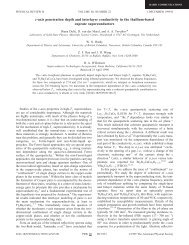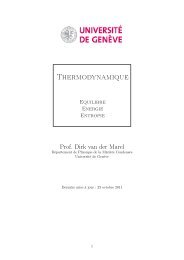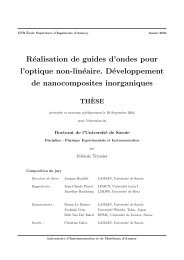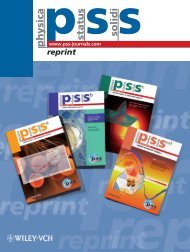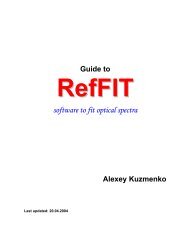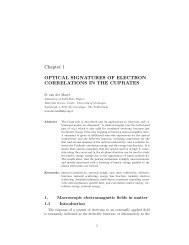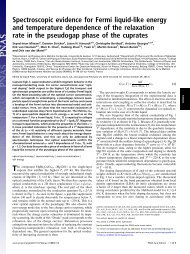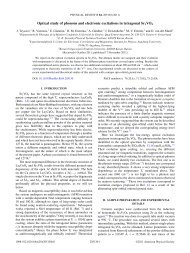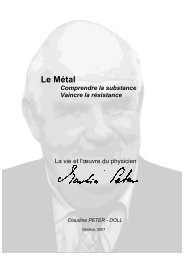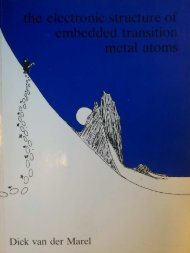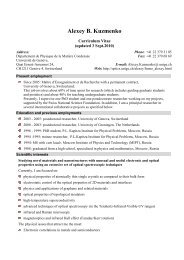Strong magnetic pair breaking in Mn-substituted MgB2 single crystals
Strong magnetic pair breaking in Mn-substituted MgB2 single crystals
Strong magnetic pair breaking in Mn-substituted MgB2 single crystals
You also want an ePaper? Increase the reach of your titles
YUMPU automatically turns print PDFs into web optimized ePapers that Google loves.
<strong>Strong</strong> <strong>magnetic</strong> <strong>pair</strong> <strong>break<strong>in</strong>g</strong> <strong>in</strong> <strong>Mn</strong>-<strong>substituted</strong> MgB 2 s<strong>in</strong>gle <strong>crystals</strong><br />
K. Rogacki, 1,2 B. Batlogg, 1 J. Karp<strong>in</strong>ski, 1 N. D. Zhigadlo, 1 G. Schuck, 1 S. M. Kazakov, 1, * P. Wägli, 1 R. Puźniak, 3<br />
A. Wiśniewski, 3 F. Carbone, 4 A. Br<strong>in</strong>kman, 4 and D. van der Marel 4<br />
1 Laboratory for Solid State Physics, ETH Zürich, 8093 Zürich, Switzerland<br />
2 Institute of Low Temperature and Structure Research, Polish Academy of Sciences, 50-950 Wroclaw, P.O.Box 1410, Poland<br />
3 Institute of Physics, Polish Academy of Sciences, Aleja Lotników 32/46, 02-668 Warsaw, Poland<br />
4 Département de Physique de la Matière Condensée, Universitée de Genève, 1211 Genève 4, Switzerland<br />
Received 24 October 2005; revised manuscript received 7 April 2006; published 23 May 2006<br />
Magnetic ions <strong>Mn</strong> were <strong>substituted</strong> <strong>in</strong> <strong>MgB2</strong> s<strong>in</strong>gle <strong>crystals</strong> result<strong>in</strong>g <strong>in</strong> a strong <strong>pair</strong>-<strong>break<strong>in</strong>g</strong> effect. The<br />
superconduct<strong>in</strong>g transition temperature, Tc,<strong>in</strong>Mg1−x<strong>Mn</strong>xB2 has been found to be rapidly suppressed at an<br />
<strong>in</strong>itial rate of 10 K/ %<strong>Mn</strong>, lead<strong>in</strong>g to a complete suppression of superconductivity at about 2% <strong>Mn</strong> substitution.<br />
This reflects the strong coupl<strong>in</strong>g between the conduction electrons and the 3d local moments, predom<strong>in</strong>antly<br />
of <strong>magnetic</strong> character, s<strong>in</strong>ce the non<strong>magnetic</strong> ion substitutions, e.g., with Al or C, suppress Tc much less<br />
effectively e.g., 0.5 K/ %Al. The magnitude of the <strong>magnetic</strong> moment 1.7 B per <strong>Mn</strong>, derived from<br />
normal state susceptibility measurements, uniquely identifies the <strong>Mn</strong> ions to be divalent, and to be <strong>in</strong> the<br />
low-sp<strong>in</strong> state S=1/2. This has been found also <strong>in</strong> x-ray absorption spectroscopy measurements. Isovalent<br />
<strong>Mn</strong>2+ substitution for Mg2+ ma<strong>in</strong>ly affects superconductivity through sp<strong>in</strong>-flip scatter<strong>in</strong>g reduc<strong>in</strong>g Tc rapidly<br />
ab<br />
/Hc2<br />
and lower<strong>in</strong>g the upper critical field anisotropy Hc2 c<br />
at T=0 from 6 to 3.3 x=0.88% <strong>Mn</strong>, while leav<strong>in</strong>g<br />
the <strong>in</strong>itial slope dHc2/dT near Tc unchanged for both field orientations.<br />
DOI: 10.1103/PhysRevB.73.174520 PACS numbers: 74.70.Ad, 74.62.Dh, 74.25.Ha, 74.25.Op<br />
I. INTRODUCTION<br />
Shortly after the discovery of 40 K superconductivity <strong>in</strong><br />
MgB 2, 1 the <strong>in</strong>tensive studies of its electronic structure revealed<br />
that this compound is a two-gap multi-band superconductor<br />
with two-dimensional 2D -band and threedimensional<br />
3D -band. 2–5 The high superconduct<strong>in</strong>g<br />
transition temperature, T c, is ma<strong>in</strong>ly associated with the<br />
-band, and T c depends on both the electron hole dop<strong>in</strong>g<br />
<strong>in</strong>tensity, which changes the Fermi level and the Fermi surface<br />
geometry, 6–8 and the <strong>in</strong>terband scatter<strong>in</strong>g, 9–12 which<br />
may also <strong>in</strong>fluence the anisotropy. 13,14 On the other hand, as<br />
<strong>in</strong> conventional superconductors, T c is expected to be affected<br />
by the <strong>pair</strong>-<strong>break<strong>in</strong>g</strong> effect caused by <strong>magnetic</strong> impurities<br />
or substitutions that suppress superconductivity due to<br />
the exchange <strong>in</strong>teraction between conduction electrons and<br />
<strong>magnetic</strong> moments of the <strong>substituted</strong> ions. 15 The <strong>magnetic</strong><br />
<strong>pair</strong>-<strong>break<strong>in</strong>g</strong> effect has been studied <strong>in</strong>tensively <strong>in</strong><br />
classic 16–22 and high-temperature superconductors, 23–27 however,<br />
this effect has rema<strong>in</strong>ed almost untouched <strong>in</strong> more exotic<br />
superconductors, particularly <strong>in</strong> two-gap multi-band<br />
MgB 2, where no experimental and only two theoretical reports<br />
on such studies have been published. 12,15 The ma<strong>in</strong><br />
goal of this work is to study the <strong>in</strong>fluence of <strong>magnetic</strong> <strong>Mn</strong>ion<br />
substitutions on the normal-state and superconduct<strong>in</strong>g<br />
properties of high-quality MgB 2 s<strong>in</strong>gle <strong>crystals</strong>. The results<br />
are analyzed and discussed <strong>in</strong> the context of non<strong>magnetic</strong> ion<br />
substitutions that affect superconductivity considerably less.<br />
In conventional superconductors the substitution of a<br />
small amount of <strong>magnetic</strong> impurities destroys superconductivity<br />
but the addition of non<strong>magnetic</strong> ions is rather harmless.<br />
In unconventional multi-band multi-gap superconductors,<br />
both <strong>magnetic</strong> and non<strong>magnetic</strong> impurities may affect<br />
superconductivity <strong>in</strong> a similar way, depend<strong>in</strong>g on <strong>in</strong>traband<br />
and <strong>in</strong>terband scatter<strong>in</strong>g. An enormous activity <strong>in</strong> experimen-<br />
PHYSICAL REVIEW B 73, 174520 2006<br />
tal and theoretical studies has been performed to expla<strong>in</strong> the<br />
puzzl<strong>in</strong>g behavior of the multi-band two-gap superconductor<br />
<strong>MgB2</strong> <strong>substituted</strong> with non<strong>magnetic</strong> ions. Here, the most <strong>in</strong>tensively<br />
studied substitutions are Al for Mg Refs. 28–32<br />
and C for B Refs. 33–36; both fill the <strong>MgB2</strong> hole-bands<br />
with electrons and also <strong>in</strong>troduce scatter<strong>in</strong>g centers that may<br />
act <strong>in</strong> different ways. In spite of this great experimental and<br />
theoretical effort, the superconduct<strong>in</strong>g and normal-state<br />
properties of <strong>MgB2</strong> <strong>substituted</strong> with <strong>magnetic</strong> ions have been<br />
<strong>in</strong>vestigated briefly and <strong>in</strong> polycrystall<strong>in</strong>e materials. 37–40<br />
Concomitantly to this work, the <strong>Mn</strong>-<strong>substituted</strong> <strong>MgB2</strong> <strong>crystals</strong><br />
from the same batches have been studied by a po<strong>in</strong>tcontact<br />
spectroscopy. 41<br />
In our previous studies we have reported on the crystallographic<br />
and superconduct<strong>in</strong>g properties of <strong>MgB2</strong> s<strong>in</strong>gle <strong>crystals</strong><br />
<strong>substituted</strong> with Al and C ions. 31,36 These electrondop<strong>in</strong>g<br />
non-<strong>magnetic</strong> substitutions result <strong>in</strong> a similar<br />
moderate decrease of the superconduct<strong>in</strong>g transition temperature,<br />
Tc, and <strong>in</strong> a different <strong>in</strong>fluence on the upper critical<br />
field. In the present study we focus <strong>in</strong> detail on the crystallographic,<br />
<strong>magnetic</strong>, and superconduct<strong>in</strong>g properties of<br />
<strong>MgB2</strong> s<strong>in</strong>gle <strong>crystals</strong> <strong>substituted</strong> with <strong>Mn</strong> ions, that act as<br />
effective <strong>magnetic</strong> scatter<strong>in</strong>g centers. We report a rapid reduction<br />
of Tc due to the <strong>Mn</strong>-ion substitution and, <strong>in</strong> contrast,<br />
a moderate <strong>in</strong>fluence of <strong>Mn</strong> on a temperature dependence of<br />
the upper critical field, Hc2, and the critical field anisotropy<br />
ab<br />
=H c2 /Hc2<br />
c . A central question <strong>in</strong> the discussion on the <strong>in</strong>-<br />
fluence of <strong>Mn</strong> on superconduct<strong>in</strong>g properties of MgB 2 is the<br />
valence state of <strong>Mn</strong> and the sp<strong>in</strong> configuration of its<br />
d-electrons. We have studied the <strong>magnetic</strong> state of <strong>Mn</strong> by<br />
measur<strong>in</strong>g the normal state magnetization and the x-ray absorption<br />
<strong>in</strong>volv<strong>in</strong>g the 3d electrons. All modifications of the<br />
superconduct<strong>in</strong>g properties are consistent with strong <strong>magnetic</strong><br />
<strong>pair</strong> <strong>break<strong>in</strong>g</strong> by <strong>Mn</strong> 2+ ions with S=1/2.<br />
1098-0121/2006/7317/1745208 174520-1<br />
©2006 The American Physical Society
ROGACKI et al. PHYSICAL REVIEW B 73, 174520 2006<br />
II. EXPERIMENTAL<br />
S<strong>in</strong>gle <strong>crystals</strong> of Mg 1−x<strong>Mn</strong> xB 2 have been grown under<br />
high pressure us<strong>in</strong>g the cubic anvil press. A mixture of Mg,<br />
<strong>Mn</strong>, B, and BN is placed <strong>in</strong> a BN crucible <strong>in</strong> a pyrophyllite<br />
cube. For example, the Mg:<strong>Mn</strong>:B:BN ratio of 9.5:0.5:12:1<br />
results <strong>in</strong> <strong>crystals</strong> with 2% of <strong>Mn</strong> <strong>substituted</strong>. The <strong>in</strong>ner<br />
diameter of the crucible is 8 mm, and its length is 8.5 mm.<br />
The heat<strong>in</strong>g element is a graphite tube. Six anvils generate<br />
pressure on the whole assembly. The typical growth process<br />
<strong>in</strong>volves: i Increas<strong>in</strong>g of pressure up to 30 kbar, ii <strong>in</strong>creas<strong>in</strong>g<br />
of temperature up to 1960 °C <strong>in</strong> 1 h, iii dwell<strong>in</strong>g<br />
for 0.5–1 h, iv lower<strong>in</strong>g the temperature and pressure <strong>in</strong><br />
1 h. As a result, Mg 1−x<strong>Mn</strong> xB 2 <strong>crystals</strong> stick<strong>in</strong>g together with<br />
BN <strong>crystals</strong> have been obta<strong>in</strong>ed. Us<strong>in</strong>g this method,<br />
Mg 1−x<strong>Mn</strong> xB 2 <strong>crystals</strong> up to 0.80.80.1 mm 3 have been<br />
grown. The phase purity of the <strong>crystals</strong> has been confirmed<br />
by x-ray diffraction. The <strong>Mn</strong> content has been determ<strong>in</strong>ed by<br />
energy dispersive x-ray EDX analyses. For all <strong>Mn</strong> substitutions<br />
from 0.4% to 7%, the <strong>crystals</strong> are s<strong>in</strong>gle phase and<br />
homogenous, at least with<strong>in</strong> ±0.04% of <strong>Mn</strong> content.<br />
The lattice parameters of <strong>Mn</strong>-<strong>substituted</strong> <strong>crystals</strong> were determ<strong>in</strong>ed<br />
by a four-circle s<strong>in</strong>gle crystal x-ray diffractometer<br />
Siemens P4 with molybdenum K 1 radiation. A set of 32<br />
reflections recorded <strong>in</strong> the range of 2 angle 15° 2<br />
32° was used to calculate the unit cell parameters. Detailed<br />
structure analysis was performed for several<br />
Mg 1−x<strong>Mn</strong> xB 2 s<strong>in</strong>gle <strong>crystals</strong> with <strong>Mn</strong> content up to x=0.07.<br />
Measurements were carried out on a Bruker SMART CCD<br />
system with molybdenum K 1 radiation. The ref<strong>in</strong>ement of<br />
Mg 1−x<strong>Mn</strong> xB 2 structure with <strong>Mn</strong> on Mg position was successful<br />
and no phase separation was observed. 42<br />
Magnetic properties <strong>in</strong> the normal and superconduct<strong>in</strong>g<br />
states were <strong>in</strong>vestigated by <strong>magnetic</strong> moment measurements<br />
performed as a function of temperature and field with a<br />
Quantum Design <strong>magnetic</strong> property measurement system<br />
QD-MPMS equipped with a 7 T superconduct<strong>in</strong>g magnet.<br />
Individual <strong>crystals</strong> with a mass of about 25 g as well as a<br />
collection of 25 <strong>crystals</strong> with a mass of 847 g were studied<br />
to obta<strong>in</strong> more reliable quantitative results. In order to determ<strong>in</strong>e<br />
the upper critical field, the <strong>magnetic</strong> moment M was<br />
measured at constant field upon heat<strong>in</strong>g from the zero-fieldcooled<br />
state ZFC mode or the field-cooled state FC mode,<br />
with a temperature sweep of 0.1 K/m<strong>in</strong>. Occasionally, M<br />
was also measured at constant temperature with <strong>in</strong>creas<strong>in</strong>g<br />
field, us<strong>in</strong>g the step-by-step option. Complementary torque<br />
measurements were performed to obta<strong>in</strong> the upper critical<br />
field properties at higher fields. The torque =MBM<br />
H was recorded as a function of the angle between the<br />
applied field and the c-axis of the crystal for various fixed<br />
temperatures and fields. For the torque measurements, a QD<br />
physical property measurement system QD-PPMS with<br />
torque option and a maximum field of 9 T was used. For<br />
details of torque measurements see Ref. 43.<br />
X-ray absorption spectroscopy XAS measurements on<br />
the 2p to 3d absorption threshold of <strong>Mn</strong> ions <strong>in</strong> MgB 2 s<strong>in</strong>gle<br />
<strong>crystals</strong> have been performed on the beam l<strong>in</strong>e BACH at<br />
“Elettra” synchrotron Trieste. 44 The spectra have been collected<br />
both <strong>in</strong> total electron yield TEY and total fluorescence<br />
yield TFY at room temperature. The TEY technique<br />
174520-2<br />
FIG. 1. Lattice parameters c and a vs <strong>Mn</strong> content x determ<strong>in</strong>ed<br />
with EDX for Mg 1−x<strong>Mn</strong> xB 2 s<strong>in</strong>gle <strong>crystals</strong> closed symbols, solid<br />
l<strong>in</strong>es. The <strong>crystals</strong> are superconduct<strong>in</strong>g for x0.02. The solid l<strong>in</strong>es<br />
are l<strong>in</strong>ear fits to the data. The dashed l<strong>in</strong>es represent the lattice<br />
parameters for Al-<strong>substituted</strong> <strong>crystals</strong> Ref. 31.<br />
measures the photoconductivity of the sample as a function<br />
of the <strong>in</strong>com<strong>in</strong>g photon energy, this quantity is directly related<br />
to the optical absorption cross section. This method is<br />
sensitive to the first 50 Å of the sample, which means that<br />
the contam<strong>in</strong>ation of the surface could affect the shape of the<br />
spectrum. The TFY method measures the <strong>in</strong>tegrated <strong>in</strong>tensity<br />
of the fluorescence decay 3d→2p as a function of the <strong>in</strong>com<strong>in</strong>g<br />
photon energy. This quantity is usually not one to<br />
one related to the optical absorption cross section because of<br />
self absorption and saturation phenomena. These phenomena<br />
are less important when the fluorescent ion is present at low<br />
concentrations, which makes TFY particularly suitable for<br />
study<strong>in</strong>g the absorption spectra of diluted solutions or impurities<br />
<strong>in</strong> <strong>crystals</strong>. 45 The ma<strong>in</strong> advantage of TFY is the bulk<br />
sensitivity, prob<strong>in</strong>g the first 200 nm of the sample. On the<br />
other hand, TFY is experimentally more demand<strong>in</strong>g, result<strong>in</strong>g<br />
<strong>in</strong> a longer acquisition time and a poorer resolution.<br />
III. RESULTS AND DISCUSSION<br />
In Fig. 1 we show the lattice parameters c and a versus<br />
<strong>Mn</strong> content for Mg 1−x<strong>Mn</strong> xB 2 s<strong>in</strong>gle <strong>crystals</strong> with x from 0 to<br />
0.067. 46 A significant l<strong>in</strong>ear decrease of 4·10 −3 Å/%<strong>Mn</strong> of<br />
the c-axis parameter with substitution is observed. Much<br />
weaker substitution effect on the c-axis parameter was found<br />
for nearly s<strong>in</strong>gle-phase polycrystall<strong>in</strong>e Mg 1−x<strong>Mn</strong> xB 2, where<br />
the <strong>Mn</strong> content was taken as the nom<strong>in</strong>al content and thus<br />
could be overestimated. 37 The variation of the a-axis parameter<br />
with x is much smaller. Similar behavior of cx and ax<br />
was reported for Al-<strong>substituted</strong> <strong>crystals</strong>, 31 and for Co- and<br />
Cr-<strong>substituted</strong> polycrystall<strong>in</strong>e materials. 38,40 The dist<strong>in</strong>ct con-
STRONG MAGNETIC PAIR BREAKING IN <strong>Mn</strong>-¼ PHYSICAL REVIEW B 73, 174520 2006<br />
FIG. 2. Normalized <strong>magnetic</strong> moment M vs temperature for the<br />
Mg 1−x<strong>Mn</strong> xB 2 s<strong>in</strong>gle <strong>crystals</strong> with various <strong>Mn</strong> content x. The measurements<br />
were performed <strong>in</strong> a field of 0.5 mT, after cool<strong>in</strong>g <strong>in</strong> a<br />
zero field. The superconduct<strong>in</strong>g transition temperature T c is marked<br />
by a solid arrow and the transition onset temperature T co by a grey<br />
arrow. Crystals with a sharp transition closed circles were selected<br />
for further studies.<br />
traction of the MgB 2 unit cell along the c-axis observed for<br />
our <strong>substituted</strong> <strong>crystals</strong> <strong>in</strong>dicates that <strong>Mn</strong> enters the crystal<br />
structure. Similar conclusion has been also derived from the<br />
s<strong>in</strong>gle crystal x-ray <strong>in</strong>vestigations where it was possible to<br />
ref<strong>in</strong>e the Mg 1−x<strong>Mn</strong> xB 2 structure with <strong>Mn</strong> on Mg position<br />
only. Consider<strong>in</strong>g the contraction of the unit cell with <strong>Mn</strong><br />
substitution, a simple comparison of the ionic radii of Mg<br />
and <strong>Mn</strong> suggests that the effective valence state of <strong>Mn</strong> can<br />
be 3+ with low-sp<strong>in</strong> as well as high-sp<strong>in</strong> configuration or<br />
2+ with low-sp<strong>in</strong> configuration only. As we will show later,<br />
the <strong>magnetic</strong> and x-ray absorption studies reveal that the <strong>Mn</strong><br />
ions <strong>substituted</strong> for Mg are divalent and <strong>in</strong> the low-sp<strong>in</strong> configuration.<br />
The superconduct<strong>in</strong>g transition temperature was determ<strong>in</strong>ed<br />
from the <strong>magnetic</strong> moment measurements performed<br />
as a function of temperature <strong>in</strong> a 0.5 mT dc field <strong>in</strong> ZFC<br />
mode. As an example, the MT results for <strong>crystals</strong> with<br />
various <strong>Mn</strong> content are shown <strong>in</strong> Fig. 2. The effective transition<br />
temperature T c and the onset temperature T co were<br />
def<strong>in</strong>ed as illustrated <strong>in</strong> Fig. 2. A broad transition to the superconduct<strong>in</strong>g<br />
state for the crystal with x=0.011 is <strong>in</strong>cluded<br />
to clearly illustrate the def<strong>in</strong>itions. A difference T c=T co<br />
−T c is identified with the sample quality and it varies from<br />
0.1 to 2.5 K at 0.5 mT, depend<strong>in</strong>g on the <strong>Mn</strong> content and<br />
synthesis conditions. Crystals with T c0.5 mT1 K were<br />
selected for further studies.<br />
Magnetic moment versus field has been measured to exam<strong>in</strong>e<br />
shield<strong>in</strong>g effects and to estimate an upper limit of the<br />
superconduct<strong>in</strong>g volume fraction for <strong>Mn</strong>-<strong>substituted</strong> <strong>crystals</strong>.<br />
Virg<strong>in</strong> magnetization curves MH were obta<strong>in</strong>ed at low temperatures<br />
for the Mg 1−x<strong>Mn</strong> xB 2 <strong>crystals</strong> with x=0.0088. For a<br />
crystal with a mass of 23.5 ±0.5 g and dimensions 0.55<br />
0.350.045 mm 3 , the superconduct<strong>in</strong>g volume fraction f<br />
=0.96 ±0.04 was derived at 10 K T0.5T c with a demagnetiz<strong>in</strong>g<br />
factor n=0.06 for H parallel to the ma<strong>in</strong> surface<br />
of the crystal. This confirms full diamagnetism of the <strong>Mn</strong><strong>substituted</strong><br />
crystal certify<strong>in</strong>g its good quality. First deviation<br />
174520-3<br />
FIG. 3. Suppression of T c with <strong>Mn</strong> substitution for Mg 1−x<strong>Mn</strong> xB 2<br />
s<strong>in</strong>gle <strong>crystals</strong> with a sharp transition to the superconduct<strong>in</strong>g state<br />
see Fig. 2. The solid l<strong>in</strong>e is a polynomial fit to the experimental<br />
po<strong>in</strong>ts. The dashed l<strong>in</strong>e shows T cx predicted by the A-G <strong>pair</strong><strong>break<strong>in</strong>g</strong><br />
theory. The <strong>in</strong>set shows T c vs the lattice parameter c. For<br />
clarity, only two error bars are shown.<br />
from the l<strong>in</strong>ear part of the MH virg<strong>in</strong> curve was used to<br />
roughly estimate the lower critical field oH c119 and<br />
12 mT at 4.5 and 10 K, respectively, for H parallel to the<br />
ab-plane. These values signify the upward curvature of the<br />
H c1 versus T dependence above 10 K at least and are<br />
similar 47 or much lower 48,49 than those observed for un<strong>substituted</strong><br />
MgB 2.<br />
The superconduct<strong>in</strong>g transition temperature systematically<br />
decreases with <strong>Mn</strong> substitution result<strong>in</strong>g <strong>in</strong> a complete<br />
suppression of superconductivity at x0.02, as shown <strong>in</strong><br />
Fig. 3. The suppression is faster than l<strong>in</strong>ear <strong>in</strong> the whole<br />
range of dop<strong>in</strong>g and can be described by the <strong>magnetic</strong> <strong>pair</strong><strong>break<strong>in</strong>g</strong><br />
effect. Accord<strong>in</strong>g to the Abrikosov-Gor’kov A-G<br />
<strong>pair</strong>-<strong>break<strong>in</strong>g</strong> theory the <strong>in</strong>teraction of <strong>magnetic</strong> impurities<br />
with conduction electrons may break the time-reversal symmetry<br />
of the Cooper-<strong>pair</strong>s and result <strong>in</strong> a rapid decrease of T c<br />
with the concentration of <strong>magnetic</strong> ions x. 50 The reduced<br />
T cx is well described by the relation lnt c= 1<br />
2<br />
− 1<br />
2<br />
+0.14t c/ cr , with t c=T cx/T c0. 51 z is digamma<br />
function, and / cr is the normalized <strong>pair</strong>-<strong>break<strong>in</strong>g</strong> parameter<br />
which is identical to x/x cr, where x cr is the concentration<br />
of <strong>magnetic</strong> impurities required to supperss T c to zero. The<br />
dependence of T cx/T c0 as a function of x/x cr follows a<br />
universal relation. For small x, T cx changes roughly l<strong>in</strong>early<br />
and drops more rapidly for x closer to x cr. For the<br />
<strong>Mn</strong>-<strong>substituted</strong> MgB 2 <strong>crystals</strong>, we found a very similar dependence<br />
see Fig. 3, however, a small deviation from the<br />
A-G curve seems to be present. This possible deviation could<br />
be a result of unconventional two-gap superconductivity,<br />
where the <strong>in</strong>terband scatter<strong>in</strong>g, which may grow with the<br />
amount of <strong>substituted</strong> <strong>magnetic</strong> ions, is postulated as an additional<br />
mechanism that reduces T c. 9–12<br />
The rapid decrease of T c caused by <strong>Mn</strong> ions is particularly<br />
clear when the <strong>Mn</strong> substitution is compared with others. In<br />
Fig. 4 we show T cx for MgB 2 <strong>crystals</strong> <strong>substituted</strong> with <strong>Mn</strong><br />
for Mg, and electron-doped Al for Mg and C for B. The<br />
dramatic suppression of T c for the <strong>Mn</strong>-<strong>substituted</strong> <strong>crystals</strong><br />
seems to be a pure <strong>magnetic</strong> <strong>pair</strong>-<strong>break<strong>in</strong>g</strong> effect, because
ROGACKI et al. PHYSICAL REVIEW B 73, 174520 2006<br />
FIG. 4. Variation of T c for MgB 2 s<strong>in</strong>gle <strong>crystals</strong> <strong>substituted</strong> with<br />
non<strong>magnetic</strong> Al, C and <strong>magnetic</strong> <strong>Mn</strong> ions. The most strik<strong>in</strong>g<br />
result is a rapid suppression of T c due to the substitution of isovalent<br />
<strong>Mn</strong> for Mg. The ma<strong>in</strong> part of the results on Al- and<br />
C-<strong>substituted</strong> <strong>crystals</strong> has been published <strong>in</strong> Refs. 31 and 36,<br />
respectively.<br />
any essential changes of the electronic structure are not expected<br />
for the reason that <strong>Mn</strong> substitutes as isovalent <strong>Mn</strong> 2+ ,<br />
as we discuss below. This requires strong <strong>in</strong>teraction between<br />
the localized 3d electrons of <strong>Mn</strong> and conduction<br />
mostly 2s2p electrons of B even if we realize that the <strong>magnetic</strong><br />
impurities are located at the Mg sites, which are spatially<br />
separated from the B planes. A large difference between<br />
the T c suppression rates for <strong>magnetic</strong> and non<strong>magnetic</strong><br />
substitutions is consistent with orthogonality of the and <br />
orbitals and, consequently, with the much smaller <strong>in</strong>terband<br />
than <strong>in</strong>traband scatter<strong>in</strong>g. 52 An <strong>in</strong>terest<strong>in</strong>g issue is if so f<strong>in</strong>e<br />
substitution of <strong>Mn</strong> for Mg, which yet changes T c so rapidly,<br />
modifies the and <strong>in</strong>traband scatter<strong>in</strong>g and <strong>in</strong>fluences the<br />
-band anisotropy. This we discuss <strong>in</strong> the paragraphs devoted<br />
to properties of the upper critical field.<br />
The normal state magnetization was measured on <strong>in</strong>dividual<br />
s<strong>in</strong>gle <strong>crystals</strong> typically m25 g and on an assembly<br />
of 25 <strong>crystals</strong> 0.88% <strong>Mn</strong>, total m847 g attached<br />
with vacuum grease to a non<strong>magnetic</strong> sample holder. The<br />
presence of <strong>Mn</strong> ions manifests itself <strong>in</strong> a Curie-Weiss contribution<br />
that dom<strong>in</strong>ates MT even at the low <strong>Mn</strong> concentrations<br />
of 1%. An example of the MT dependence is shown<br />
<strong>in</strong> Fig. 5 for the multi-crystal assembly. For <strong>in</strong>dividual <strong>crystals</strong>,<br />
MH curves were measured at various temperatures to<br />
calculate MT, s<strong>in</strong>ce the small crystal mass and the low <strong>Mn</strong><br />
content resulted <strong>in</strong> 10 −8 –10 −7 mol <strong>Mn</strong>. The normal state<br />
<strong>magnetic</strong> moment was analyzed accord<strong>in</strong>g to the formula<br />
MT=M o+C /T+, where C /T+ is the Curie-Weiss<br />
contribution associated with the <strong>Mn</strong> local moments. The effective<br />
<strong>in</strong>teraction temperature is found to be 2 K, reflect<strong>in</strong>g<br />
the high dilution of the <strong>Mn</strong> ions. The value of C is<br />
shown <strong>in</strong> the <strong>in</strong>set of Fig. 5 for MT measurements <strong>in</strong> fields<br />
up to 5 T, and for H either parallel to or 70° off the crystal<br />
ab-plane. C H is isotropic with<strong>in</strong> the measurement limits<br />
and grows l<strong>in</strong>early with H, as expected.<br />
The magnitude of the local-moment Curie-Weiss part of<br />
MT reveals unambiguously that <strong>Mn</strong> <strong>in</strong> MgB 2 is <strong>in</strong> the di-<br />
174520-4<br />
FIG. 5. Temperature dependence of the <strong>magnetic</strong> moment M at<br />
a constant field oH=5 T for MgB 2 s<strong>in</strong>gle <strong>crystals</strong> <strong>substituted</strong> with<br />
0.88% of <strong>Mn</strong>. The sample consists of 25 <strong>crystals</strong> with T c<br />
28±1 K and a total mass of 847 g 1.6110 −7 mol <strong>Mn</strong>. The<br />
<strong>in</strong>set shows the Curie part C of the MT dependence as obta<strong>in</strong>ed<br />
from the experiment circles. The l<strong>in</strong>es are the expectations for C <br />
based on <strong>Mn</strong> 2+ solid l<strong>in</strong>es or <strong>Mn</strong> 3+ dashed l<strong>in</strong>es <strong>in</strong> the high-sp<strong>in</strong><br />
HS and low-sp<strong>in</strong> LS configuration. The measurements reveal<br />
<strong>Mn</strong> to be divalent <strong>in</strong> the low-sp<strong>in</strong> configuration. H was oriented<br />
either parallel to the ab-plane open circles or 70° off the ab-plane<br />
solid circles.<br />
valent state, isovalent to Mg. The l<strong>in</strong>es <strong>in</strong> the <strong>in</strong>set of Fig. 5<br />
are the calculated values of C H, assum<strong>in</strong>g <strong>Mn</strong> 2+ and<br />
<strong>Mn</strong> 3+ , <strong>in</strong> either high-sp<strong>in</strong> or low-sp<strong>in</strong> state. The measured<br />
data, which correspond to m m1.7 B per <strong>Mn</strong> ion, are <strong>in</strong><br />
excellent agreement with low-sp<strong>in</strong> <strong>Mn</strong> 2+ , and they are clearly<br />
dist<strong>in</strong>ct from the alternative states. Thus, we conclude that<br />
the crystal field act<strong>in</strong>g upon the d electrons is strong enough<br />
to produce a low-sp<strong>in</strong> configuration with an effective S<br />
=1/2. Measurements on other <strong>crystals</strong>, <strong>in</strong>clud<strong>in</strong>g one with<br />
6.5% <strong>Mn</strong>, lead to the same conclusion.<br />
Information on the d-electron configuration can be deduced<br />
also from x-ray absorption spectroscopy XAS. The<br />
2p to 3d XAS spectrum <strong>in</strong> transition metals has been proved<br />
to be a sensitive probe to their electronic ground state. 53 It is<br />
possible to calculate the XAS spectrum with a standard<br />
Cowan code, 54 based on an atomic model, and compare it to<br />
the experimental spectra. This approach is very suitable for<br />
the determ<strong>in</strong>ation of the valency of transition metal impurities<br />
<strong>in</strong> <strong>crystals</strong>. In Fig. 6 we show the experimental TEY and<br />
TFY spectra see Experimental together with the atomic<br />
model calculations without and with a cubic crystal field,<br />
which mimics the presence of the solid around the <strong>Mn</strong> ion.<br />
In the upper panel of Figure 6 the TEY spectrum shows the<br />
typical shape of the high-sp<strong>in</strong> Hund’s rule ground state. The<br />
TFY measurements, though the resolution does not allow to<br />
dist<strong>in</strong>guish very clear features, show a shoulder on the low<br />
energy side of the L 2 edge and a shift of the white l<strong>in</strong>e by<br />
about 2 eV towards higher energies. In the lower panel we<br />
plot three simulations of the <strong>Mn</strong> 2+ XAS spectrum without<br />
consider<strong>in</strong>g any crystal field and with a cubic crystal field<br />
just above the high-sp<strong>in</strong> to low-sp<strong>in</strong> transition value, which<br />
for <strong>Mn</strong> is around 2.4 eV. The ligand field value at the <strong>Mn</strong><br />
site has been obta<strong>in</strong>ed perform<strong>in</strong>g a band calculation assum-
STRONG MAGNETIC PAIR BREAKING IN <strong>Mn</strong>-¼ PHYSICAL REVIEW B 73, 174520 2006<br />
FIG. 6. a XAS spectra for the TEY and the TFY experiments<br />
on MgB 2 s<strong>in</strong>gle <strong>crystals</strong> <strong>substituted</strong> with 6.7% of <strong>Mn</strong>. In the TEY<br />
mode, the spectrum is probably dom<strong>in</strong>ated by a <strong>Mn</strong>O surface layer,<br />
while the TFY mode is more sensitive to the bulk. b Atomic<br />
model calculations for the 3d 5 ground state of <strong>Mn</strong> <strong>in</strong> the low-sp<strong>in</strong><br />
LS and high-sp<strong>in</strong> HS configuration. All the curves are shifted for<br />
clarity.<br />
<strong>in</strong>g the MgB 2 crystal structure and replac<strong>in</strong>g all the Mg atoms<br />
with <strong>Mn</strong> atoms; this calculation gives a crystal field<br />
value of about 2 eV, which as a first approximation is close<br />
enough to the value necessary to <strong>in</strong>duce the high-sp<strong>in</strong> to<br />
low-sp<strong>in</strong> transition <strong>in</strong> <strong>Mn</strong>. The effect of the crystal field on<br />
the spectrum is to shift the white l<strong>in</strong>e at higher energies by an<br />
amount which is related to the crystal field value itself; a<br />
peak on the low energy side of the spectrum also arises,<br />
which <strong>in</strong> a spectrum with lower resolution becomes a pronounced<br />
shoulder. Our <strong>in</strong>terpretation is that the <strong>Mn</strong> present<br />
on the surface is probably oxidized, giv<strong>in</strong>g to the TEY spectrum<br />
the typical shape of the high-sp<strong>in</strong> ground state. The<br />
surface contam<strong>in</strong>ation of MgB 2 when <strong>crystals</strong> are exposed to<br />
air has already been po<strong>in</strong>ted out with optical experiments. 55<br />
However, the TFY spectrum reveals the bulk properties of<br />
the sample, suggest<strong>in</strong>g that the <strong>Mn</strong> 2+ ions are <strong>in</strong> a low-sp<strong>in</strong><br />
configuration <strong>in</strong>duced by the crystal field effect. This result is<br />
consistent with our <strong>magnetic</strong> measurements, discussed<br />
above.<br />
The upper critical field, H c2, has been determ<strong>in</strong>ed from<br />
<strong>magnetic</strong> moment measurements performed as a function of<br />
temperature at constant field or versus field at constant temperature.<br />
In Fig. 7 we show examples of MT and MH<br />
results for the crystal <strong>substituted</strong> with 0.88% of <strong>Mn</strong>. The<br />
results have been obta<strong>in</strong>ed with a field oriented parallel, H ab ,<br />
and perpendicular, H c ,totheab-plane. The superconduct<strong>in</strong>g<br />
transition temperature T c and the transition onset temperature<br />
T co have been def<strong>in</strong>ed as shown <strong>in</strong> Fig. 7. The difference<br />
between T c and T co obviously depends on the field orientation<br />
and value, however this modifies the H c2T results only<br />
slightly see Fig. 8. Extensive sets of data similar to these<br />
presented <strong>in</strong> Fig. 7 are analyzed to construct the H c2−T<br />
phase diagram. Figure 8 shows the upper critical field of the<br />
Mg 1−x<strong>Mn</strong> xB 2 <strong>crystals</strong> with x=0.0042 and 0.0088, and, for<br />
comparison, of the un<strong>substituted</strong> compound. For the heavily<br />
174520-5<br />
FIG. 7. Dia<strong>magnetic</strong> response of the MgB 2 crystal <strong>substituted</strong><br />
with 0.88% of <strong>Mn</strong>. Shown are examples of measurements <strong>in</strong> constant<br />
field or at constant temperature <strong>in</strong>set, for the two ma<strong>in</strong> orientations<br />
of the field. The transition temperature T c and the transition<br />
onset temperature T co are marked by arrows.<br />
doped crystal, special attention has been paid to obta<strong>in</strong> accurate<br />
H c2 values at low fields to determ<strong>in</strong>e the upper critical<br />
field slope, dH c2/dT, near T c. For this crystal x=0.0088,<br />
T c=26.8 K, d oH c2/dT at T c is equal to −0.205±0.005<br />
and −0.100±0.005 T/K, for H oriented parallel and perpendicular<br />
to the ab-plane, respectively. These values are<br />
practically the same as for un<strong>substituted</strong> <strong>crystals</strong>: −0.21 and<br />
−0.10 T/K, respectively.<br />
Accord<strong>in</strong>g to the quasi-classic model of the two-band superconductor<br />
<strong>in</strong> the dirty limit without <strong>magnetic</strong> impurities,<br />
the temperature dependence of H c2 close to T c is determ<strong>in</strong>ed<br />
by the <strong>in</strong>traband scatter<strong>in</strong>g for the band with a maximum<br />
FIG. 8. Upper critical field H c2 vs temperature for the<br />
Mg 1−x<strong>Mn</strong> xB 2 s<strong>in</strong>gle <strong>crystals</strong> with x=0 diamonds, 0.0042 circles,<br />
and 0.0088 triangles, stars. The H c2T data were obta<strong>in</strong>ed by<br />
magnetization measurements solid symbols or derived from<br />
torque measurements open symbols, for the <strong>magnetic</strong> field H oriented<br />
parallel solid l<strong>in</strong>es and perpendicular dashed l<strong>in</strong>es to the<br />
ab-plane. The magnetization measurements were performed at constant<br />
H with <strong>in</strong>creas<strong>in</strong>g T solid triangles or at constant T with<br />
<strong>in</strong>creas<strong>in</strong>g H stars. The doted l<strong>in</strong>es show the H c2T correspond<strong>in</strong>g<br />
to the transition onset temperature T co see Fig. 7. The l<strong>in</strong>es are a<br />
guide for the eye.
ROGACKI et al. PHYSICAL REVIEW B 73, 174520 2006<br />
diffusivity, when assumed that the <strong>in</strong>traband and <strong>in</strong>terband<br />
electron-phonon coupl<strong>in</strong>g constants are f<strong>in</strong>ite. 56,57 For pure<br />
<strong>MgB2</strong>, the band with a maximum diffusivity is the<br />
-band. 52,58,59 Thus, the unchanged dHc2/dT, observed for<br />
the <strong>Mn</strong>-<strong>substituted</strong> <strong>MgB2</strong> <strong>crystals</strong> close to Tc, suggests that<br />
the -band diffusivity or scatter<strong>in</strong>g is not affected by the<br />
low-level substitution of <strong>magnetic</strong> isovalent ions for Mg. As<br />
a consequence, the diffusivity <strong>in</strong> the -band rema<strong>in</strong>s dom<strong>in</strong>ant<br />
and the upper critical field at zero temperature, Hc20, should be determ<strong>in</strong>ed by Tc and the m<strong>in</strong>imum diffusivity, 57<br />
i.e., the diffusivity <strong>in</strong> the -band. A roughly l<strong>in</strong>ear Hc20 −Tc relation is observed for the <strong>Mn</strong>-<strong>substituted</strong> <strong>crystals</strong>.<br />
Thus, the <strong>Mn</strong> substitution causes merely m<strong>in</strong>imal changes <strong>in</strong><br />
the -band and the -band diffusivity, and suppresses Tc by<br />
sp<strong>in</strong>-flip scatter<strong>in</strong>g. Similar conclusions have been drawn<br />
from a po<strong>in</strong>t-contact spectroscopy. 41<br />
There are at least two mechanisms possible for the reduction<br />
of Tc <strong>in</strong> <strong>MgB2</strong> <strong>substituted</strong> with <strong>magnetic</strong> isovalent ions.<br />
One is the impurity-<strong>in</strong>duced non<strong>magnetic</strong> <strong>in</strong>terband scatter<strong>in</strong>g<br />
and the second is the <strong>magnetic</strong> <strong>pair</strong>-<strong>break<strong>in</strong>g</strong> effect. The<br />
<strong>in</strong>terband scatter<strong>in</strong>g alone is expected to reduce Tc at most to<br />
about 25 K and, most likely, for the amount of <strong>substituted</strong><br />
ions much higher than 2%, 10,11 that for the <strong>Mn</strong>-<strong>substituted</strong><br />
<strong>crystals</strong> suppresses Tc to zero. Moreover, any significant<br />
modification of the <strong>in</strong>terband scatter<strong>in</strong>g requires a substantial<br />
concentration of the impurity ions <strong>in</strong> the B plane rather than<br />
<strong>in</strong> the Mg plane, 52,60,61 as shown for C-<strong>substituted</strong> <strong>MgB2</strong>. 11,62<br />
Thus, the ma<strong>in</strong> mechanism that controls Tc <strong>in</strong> the <strong>Mn</strong><strong>substituted</strong><br />
<strong>MgB2</strong> rema<strong>in</strong>s the <strong>magnetic</strong> <strong>pair</strong>-<strong>break<strong>in</strong>g</strong> effect.<br />
The overall temperature dependence of Hc2 is characterized<br />
ma<strong>in</strong>ly by a reduction of the scales when <strong>Mn</strong> is <strong>substituted</strong>.<br />
In particular, the anisotropy rema<strong>in</strong>s well pronounced,<br />
ab<br />
and so does the marked up-turn of Hc2 below Tc, which<br />
means that the two-band character determ<strong>in</strong><strong>in</strong>g Hc2T is essentially<br />
unaffected by <strong>Mn</strong> substitution. This is <strong>in</strong> l<strong>in</strong>e with<br />
the above-noted unchanged <strong>in</strong>itial slope of dHc2/dT. In Fig.<br />
9 we show the temperature dependence of the upper critical<br />
ab c<br />
field anisotropy, =H c2 /Hc2,<br />
for the <strong>MgB2</strong> s<strong>in</strong>gle <strong>crystals</strong><br />
<strong>substituted</strong> with 0.42% and 0.88% of <strong>Mn</strong>. For comparison,<br />
the anisotropy for non<strong>substituted</strong>, Al-<strong>substituted</strong>, and<br />
C-<strong>substituted</strong> <strong>crystals</strong> is also presented. At low temperatures,<br />
a large reduction of from 6 to 3.3 is observed for the<br />
crystal with 0.88% of <strong>Mn</strong>. Along with the lower<strong>in</strong>g of , its<br />
temperature dependence weakens. This behavior, observed<br />
for the MgB 2 <strong>crystals</strong> <strong>substituted</strong> with <strong>magnetic</strong> isovalent<br />
<strong>Mn</strong> 2+ , is similar to that obta<strong>in</strong>ed for the <strong>crystals</strong> <strong>substituted</strong><br />
with electron-add<strong>in</strong>g Al 3+ . Similar T dependencies are observed<br />
for <strong>crystals</strong> with similar T c’s but with much different<br />
<strong>Mn</strong> and Al contents lower substitution or for <strong>crystals</strong> with<br />
significantly different T c’s heavier substitution, see Fig. 9.<br />
For example, 0.42% 1% of <strong>substituted</strong> <strong>Mn</strong> results <strong>in</strong><br />
changes similar to those observed for 2.4% 9% of <strong>substituted</strong><br />
Al. Thus, the mechanism that is responsible for the<br />
reduction of the anisotropy and for changes of its temperature<br />
dependence has to be different <strong>in</strong> the both cases. Note,<br />
that the temperature dependence of obta<strong>in</strong>ed for the <strong>Mn</strong>and<br />
Al-<strong>substituted</strong> <strong>crystals</strong> differs significantly from that derived<br />
for the C-<strong>substituted</strong> <strong>crystals</strong>. This we discuss shortly<br />
<strong>in</strong> the next paragraph.<br />
174520-6<br />
FIG. 9. Upper critical field anisotropy vs reduced temperature<br />
for the MgB 2 un<strong>substituted</strong> s<strong>in</strong>gle <strong>crystals</strong> diamonds; T c=38.2 K<br />
and <strong>substituted</strong> with <strong>Mn</strong> squares; 0.42% <strong>Mn</strong>, T c=33.9 K; 0.88%<br />
<strong>Mn</strong>, T c=26.8 K,Altriangles; 2.4% Al, 35.3 K; 9.2% Al, 32.0 K,<br />
and C circles; 5% C, 34.3 K; 9.5% C, 30.1 K. The data for Aland<br />
C-<strong>substituted</strong> <strong>crystals</strong> were derived from H c2T results published<br />
<strong>in</strong> Refs. 31 and 36.<br />
The upper critical field anisotropy decreases with <strong>in</strong>creas<strong>in</strong>g<br />
temperature for both un<strong>substituted</strong> and <strong>substituted</strong> <strong>crystals</strong>,<br />
as shown <strong>in</strong> Fig. 9. For a weak-coupl<strong>in</strong>g multiband BCS<br />
model for two-gap superconductors without <strong>magnetic</strong> impurities,<br />
a negative anisotropy slope, d/dT, is expected for<br />
the case when diffusivity <strong>in</strong> the -band dom<strong>in</strong>ates. 57 This<br />
requirement seems to be fulfilled <strong>in</strong> the clean non<strong>substituted</strong><br />
or C-<strong>substituted</strong> MgB 2, where C on the B position decreases<br />
the diffusivity ma<strong>in</strong>ly <strong>in</strong> the -band, as shown for<br />
C-<strong>substituted</strong> s<strong>in</strong>gle <strong>crystals</strong> 63 and epitaxial th<strong>in</strong> films. 64<br />
Thus, the negative slope d/dt, which at lower temperatures<br />
t=T/T c0.5 is similar for non<strong>substituted</strong> and<br />
C-<strong>substituted</strong> <strong>crystals</strong> see Fig. 9, is fully consistent with<br />
this prediction. On the other hand, when the diffusivity <strong>in</strong> the<br />
-band dom<strong>in</strong>ates, T is expected to be less temperature<br />
dependent, or d/dt may even become positive. 57,65 The diffusivity<br />
<strong>in</strong> the -band may dom<strong>in</strong>ate, when the scatter<strong>in</strong>g <strong>in</strong><br />
the -band <strong>in</strong>creases substantially, e.g., due to the substitution<br />
of Al for Mg. 66 Both <strong>Mn</strong> and Al substitutions show a<br />
tendency to lower d/dt with the <strong>in</strong>creas<strong>in</strong>g amount of <strong>substituted</strong><br />
ions. For an un<strong>substituted</strong> crystal T c=38.2 K,<br />
d/dt=2.6 at t=0.4 and decreases slightly to about 2.3, for<br />
the <strong>crystals</strong> with 0.42% of <strong>Mn</strong> T c=33.9 K or 2.4% of Al<br />
T c=35.3 K, and more significantly to 0.91 and 0.42, for the<br />
<strong>crystals</strong> with 0.88% of <strong>Mn</strong> T c=26.8 K and 9.2% of Al<br />
T c=32.0 K, respectively.<br />
For the Al-<strong>substituted</strong> <strong>crystals</strong>, the observed suppression<br />
of d/dt can be <strong>in</strong>terpreted as a result of <strong>in</strong>creased <strong>in</strong>traband<br />
scatter<strong>in</strong>g <strong>in</strong> the -band. 66 For the <strong>Mn</strong>-<strong>substituted</strong> <strong>crystals</strong>,<br />
the explanation seems to be different, as dH c2/dT at T c<br />
rema<strong>in</strong>s unchanged. Here, <strong>pair</strong> <strong>break<strong>in</strong>g</strong> due to sp<strong>in</strong>-flip scatter<strong>in</strong>g<br />
appears to dom<strong>in</strong>ate the reduction of T c and the H c2<br />
anisotropy. A reduction of the energy gap due to sp<strong>in</strong>-flip<br />
scatter<strong>in</strong>g is expected to be different for both bands and thus<br />
the ratio / may vary with temperature <strong>in</strong> a way that is<br />
different from that <strong>in</strong> un<strong>substituted</strong> MgB 2. The details can be
STRONG MAGNETIC PAIR BREAKING IN <strong>Mn</strong>-¼ PHYSICAL REVIEW B 73, 174520 2006<br />
worked out through T-dependent gap spectroscopy reveal<strong>in</strong>g<br />
changes <strong>in</strong> the magnitude and weaken<strong>in</strong>g of the temperature<br />
dependence of and due to sp<strong>in</strong>-flip scatter<strong>in</strong>g. Such<br />
spectroscopic studies may also reveal if some of the scenarios<br />
discussed theoretically for <strong>magnetic</strong> <strong>pair</strong> <strong>break<strong>in</strong>g</strong> <strong>in</strong><br />
MgB 2 apply to this compound. 15<br />
IV. CONCLUSIONS<br />
We have studied the <strong>in</strong>fluence of <strong>Mn</strong> substitution on the<br />
superconduct<strong>in</strong>g properties of MgB 2 by grow<strong>in</strong>g s<strong>in</strong>gle <strong>crystals</strong><br />
with <strong>Mn</strong> concentrations up to 7%, and measur<strong>in</strong>g their<br />
<strong>magnetic</strong> properties and x-ray absorption spectra. <strong>Mn</strong> suppresses<br />
T c very effectively at an <strong>in</strong>itial rate of 10 K/ %<strong>Mn</strong>,<br />
and T c is fully suppressed at 2% of <strong>Mn</strong>. The temperature<br />
dependence of H c2T and T obta<strong>in</strong>ed for the <strong>Mn</strong><strong>substituted</strong><br />
s<strong>in</strong>gle <strong>crystals</strong> is similar to that reported previously<br />
for MgB 2 <strong>substituted</strong> with non<strong>magnetic</strong> Al, provided<br />
that the <strong>crystals</strong> with similar T c are compared. This suggests<br />
that <strong>in</strong> MgB 2, where Mg is <strong>substituted</strong> with <strong>magnetic</strong> or non<strong>magnetic</strong><br />
ions, the ma<strong>in</strong> parameter that controls both H c2T<br />
and T is the superconduct<strong>in</strong>g transition temperature, irrespective<br />
of the mechanism responsible for the T c suppression.<br />
For <strong>Mn</strong>-<strong>substituted</strong> MgB 2, this suppression is found to<br />
be due to the <strong>magnetic</strong> <strong>pair</strong>-<strong>break<strong>in</strong>g</strong> effect caused by <strong>Mn</strong><br />
*Present address: Department of Chemistry, Moscow State University,<br />
119899 Moscow, Russia.<br />
1J. Nagamatsu, N. Nakagawa, T. Muranaka, Y. Zenitani, and J.<br />
Akimitsu, Nature London 410, 632001.<br />
2J. Kortus, I. I. Maz<strong>in</strong>, K. D. Belashchenko, V. P. Antropov, and L.<br />
L. Boyer, Phys. Rev. Lett. 86, 4656 2001.<br />
3A. Y. Liu, I. I. Maz<strong>in</strong>, and J. Kortus, Phys. Rev. Lett. 87, 087005<br />
2001.<br />
4H. J. Choi, D. Roundy, H. Sun, M. L. Cohen, and S. G. Louie,<br />
Nature London 418, 758 2002.<br />
5For a review, see P. C. Canfield and G. W. Crabtree, Phys. Today<br />
56, 342003.<br />
6O. de la Peña, A. Aguayo, and R. de Coss, Phys. Rev. B 66,<br />
012511 2002.<br />
7D. Kas<strong>in</strong>athan, K.-W. Lee, and W. E. Pickett, Physica C 424, 116<br />
2005.<br />
8R. F. Klie, J. C. Zheng, Y. Zhu, A. J. Zambano, and L. D. Cooley,<br />
Phys. Rev. B 73, 014513 2006.<br />
9A. A. Golubov, J. Kortus, O. V. Dolgov, O. Jepsen, Y. Kong, O.<br />
K. Andersen, B. J. Gibson, K. Ahn, and R. K. Kremer, J. Phys.:<br />
Condens. Matter 14, 1353 2002.<br />
10B. Mitrović, J. Phys.: Condens. Matter 16, 9013 2004.<br />
11J. Kortus, O. V. Dolgov, R. K. Kremer, and A. A. Golubov, Phys.<br />
Rev. Lett. 94, 027002 2005.<br />
12O. V. Dolgov, R. K. Kremer, J. Kortus, A. A. Golubov, and S. V.<br />
Shulga, Phys. Rev. B 72, 024504 2005.<br />
13A. A. Golubov and I. I. Maz<strong>in</strong>, Phys. Rev. B 55, 15146 1997.<br />
14M. Angst, S. L. Bud’ko, R. H. T. Wilke, and P. C. Canfield, Phys.<br />
Rev. B 71, 144512 2005.<br />
174520-7<br />
ions, as <strong>Mn</strong> substitutes for Mg isovalently as <strong>Mn</strong> 2+ <strong>in</strong> the<br />
low-sp<strong>in</strong> S=1/2 configuration. Along with the reduction of<br />
T c, the upper critical field H c20 and its anisotropy are also<br />
reduced, while the <strong>in</strong>itial slope dH c2/dT near T c and the<br />
associated anisotropy rema<strong>in</strong> essentially unaffected. These<br />
results suggest that the <strong>magnetic</strong> <strong>Mn</strong> substitution predom<strong>in</strong>antly<br />
<strong>in</strong>fluences the superconduct<strong>in</strong>g properties through<br />
sp<strong>in</strong>-flip scatter<strong>in</strong>g, leav<strong>in</strong>g the diffusivity <strong>in</strong> the and <br />
bands largely unaffected. A further treatment will have to<br />
<strong>in</strong>clude the detailed knowledge of the <strong>in</strong>fluence of <strong>magnetic</strong><br />
<strong>pair</strong> <strong>break<strong>in</strong>g</strong> on the and bands <strong>in</strong> MgB 2 and the result<strong>in</strong>g<br />
modification of the electronic properties of this two-gap<br />
superconductor.<br />
ACKNOWLEDGMENTS<br />
This work was supported <strong>in</strong> part by the Swiss National<br />
Science Foundation, MaNEP, the Center of Excellence<br />
CELTAM established under the Grant No. GMA1-2002-<br />
72017 with<strong>in</strong> 5th Framework Program of European Community<br />
Contract No. G5MA-CT.2002.04032 K.R., and the<br />
Polish State Committee for Scientific Research under a research<br />
project for the years 2004–2006 1 P03B 037 27<br />
R.P. and A.W.. The SMART CCD measurements were performed<br />
at the Laboratory of Inorganic Chemistry, ETH Zurich.<br />
15C. P. Moca and C. Horea, Phys. Rev. B 66, 052501 2002.<br />
16For a review, see Ø. Fischer, Appl. Phys. 16, 11978.<br />
17For a review, see K. N. Shrivastava and K. P. S<strong>in</strong>ha, Phys. Rep.<br />
115, 931984.<br />
18A. I. Goldman, C. Stassis, P. C. Canfield, J. Zarestky, P. Dervenagas,<br />
B. K. Cho, D. C. Johnston, and B. Stemlieb, Phys. Rev. B<br />
50, R9668 1994.<br />
19J. A. Chervenak and J. M. Valles, Phys. Rev. B 51, 11977 1995.<br />
20A. Bill, S. A. Wolf, Yu. N. Ovch<strong>in</strong>nikov, and V. Z. Kres<strong>in</strong>,<br />
Physica C 298, 231 1998.<br />
21G. Ghosh, A. D. Ch<strong>in</strong>chure, R. Nagarajan, C. Godart, and L. C.<br />
Gupta, Phys. Rev. B 63, 212505 2001.<br />
22Chang-An Kim and B. K. Cho, Phys. Rev. B 66, 214501 2002.<br />
23G. Xiao, M. Z. Cieplak, J. Q. Xiao, and C. L. Chien, Phys. Rev.<br />
B 42, 8752 1990.<br />
24P. Szabó, P. Samuely, A. G. M. Jansen, J. Marcus, and P. Wyder,<br />
Phys. Rev. B 62, 3502 2000.<br />
25A. K. Chattopadhyay, R. A. Klemm, and D. Sa, J. Phys.: Condens.<br />
Matter 14, L577 2002.<br />
26A. Poddar and B. Chattopadhyay, Eur. Phys. J. B 35, 692003.<br />
27K. Rogacki, Phys. Rev. B 68, 100507R 2003.<br />
28J. S. Slusky, N. Rogado, K. A. Regan, M. A. Hayward, P. Khalifah,<br />
T. He, K. Inumaru, S. M. Loureiro, M. K. Haas, H. W.<br />
Zandbergen, and R. J. Cava, Nature London 410, 343 2001.<br />
29R. J. Cava, H. W. Zandbergen, and K. Inumaru, Physica C 385, 8<br />
2003.<br />
30M. Putti, M. Affronte, P. Manfr<strong>in</strong>etti, and A. Palenzona, Phys.<br />
Rev. B 68, 094514 2003.<br />
31J. Karp<strong>in</strong>ski, N. D. Zhigadlo, G. Schuck, S. M. Kazakov, B. Bat-
ROGACKI et al. PHYSICAL REVIEW B 73, 174520 2006<br />
logg, K. Rogacki, R. Puzniak, J. Jun, E. Müller, P. Wägli, R.<br />
Gonnelli, D. Daghero, G. A. Ummar<strong>in</strong>o, and V. A. Stepanov,<br />
Phys. Rev. B 71, 174506 2005.<br />
32A. J. Zambano, A. R. Moodenbaugh, and L. D. Cooley, Supercond.<br />
Sci. Technol. 18, 1411 2005.<br />
33A. Bharathi, S. J. Balaselvi, S. Kalavathi, G. L. N. Reddy, V. S.<br />
Sastry, Y. Hariharan, and T. S. Radhakrishnan, Physica C 370,<br />
211 2002.<br />
34S. Lee, T. Masui, A. Yamamoto, H. Uchiyama, and S. Tajima,<br />
Physica C 397, 72003.<br />
35T. Masui, S. Lee, and S. Tajima, Phys. Rev. B 70, 024504 2004.<br />
36S. M. Kazakov, R. Puzniak, K. Rogacki, A. V. Mironov, N. D.<br />
Zhigadlo, J. Jun, Ch. Soltmann, B. Batlogg, and J. Karp<strong>in</strong>ski,<br />
Phys. Rev. B 71, 024533 2005.<br />
37S. Xu, Y. Moritomo, K. Kato, and A. Nakamura, J. Phys. Soc.<br />
Jpn. 70, 1889 2001.<br />
38M. Kühberger and G. Gritzner, Physica C 370, 392002.<br />
39S. X. Dou, S. Soltanian, Y. Zhao, E. Get<strong>in</strong>, Z. Chen, O. Shcherbakova,<br />
and J. Horvat, Supercond. Sci. Technol. 18, 710 2005.<br />
40H. Zhang, J. Zhao, and L. Shi, Physica C 424, 792005.<br />
41R. S. Gonnelli, D. Daghero, G. A. Ummar<strong>in</strong>o, A. Calzolari, M.<br />
Tortello, V. A. Stepanov, N. D. Zhigadlo, K. Rogacki, and J.<br />
Karp<strong>in</strong>ski, cond-mat/0510329 unpublished.<br />
42For details, see G. Schuck et al. <strong>in</strong> preparation.<br />
43M. Angst, R. Puzniak, A. Wisniewski, J. Jun, S. M. Kazakov, J.<br />
Karp<strong>in</strong>ski, J. Roos, and H. Keller, Phys. Rev. Lett. 88, 167004<br />
2002.<br />
44M. Zangrando, M. F<strong>in</strong>azzi, G. Paolucci, G. Comelli, B. Diviacco,<br />
R. P. Walker, D. Cocco, and F. Parmigiani, Rev. Sci. Instrum.<br />
72, 1313 2001.<br />
45F. M. F. de Groot, M. A. Arrio, Ph. Sa<strong>in</strong>ctavit, Ch. Cartier, and C.<br />
T. Chen, Solid State Commun. 92, 991 1994.<br />
46For the crystallographic structure see Ref. 1.<br />
47M. Zehetmayer, M. Eisterer, J. Jun, S. M. Kazakov, J. Karp<strong>in</strong>ski,<br />
A. Wisniewski, and H. W. Weber, Phys. Rev. B 66, 052505<br />
2002.<br />
48G. K. Perk<strong>in</strong>s, J. Moore, Y. Bugoslavsky, L. F. Cohen, J. Jun, S.<br />
M. Kazakov, J. Karp<strong>in</strong>ski, and A. D. Capl<strong>in</strong>, Supercond. Sci.<br />
Technol. 15, 1156 2002.<br />
49L. Lyard, P. Szabó, T. Kle<strong>in</strong>, J. Marcus, C. Marcenat, K. H. Kim,<br />
B. W. Kang, H. S. Lee, and S. I. Lee, Phys. Rev. Lett. 92,<br />
057001 2004.<br />
174520-8<br />
50A. A. Abrikosov and L. P. Gor’kov, ZETF 39, 1781 1960 ,<br />
Sov. Phys. JETP 12, 1243 1961.<br />
51R. D. Parks, <strong>in</strong> Superconductivity, edited by P. R. Wallace Gordon<br />
and Breach, New York, 1969, Vol. 2, 625.<br />
52I. I. Maz<strong>in</strong>, O. K. Andersen, O. Jepsen, O. V. Dolgov, J. Kortus,<br />
A. A. Golubov, A. B. Kuz’menko, and D. van der Marel, Phys.<br />
Rev. Lett. 89, 107002 2002.<br />
53B. T. Thole, R. D. Cowan, G. A. Sawatzky, J. F<strong>in</strong>k, and J. C.<br />
Fuggle, Phys. Rev. B 31, 6856 1985.<br />
54R. D. Cowan, The Theory of Atomic Structure and Spectra University<br />
of California Press, Berkeley, 1981.<br />
55V. Guritanu, A. B. Kuzmenko, D. van der Marel, S. M. Kazakov,<br />
N. D. Zhigadlo, and J. Karp<strong>in</strong>ski, Phys. Rev. B 73, 104509<br />
2006.<br />
56H. Suhl, B. T. Matthias, and L. R. Walker, Phys. Rev. Lett. 3, 552<br />
1959.<br />
57A. Gurevich, Phys. Rev. B 67, 184515 2003.<br />
58M. Putti, V. Bracc<strong>in</strong>i, E. Galleani d’Agliano, F. Napoli, I. Pallecchi,<br />
A. S. Siri, P. Manfr<strong>in</strong>etti, and A. Palenzona, Phys. Rev. B<br />
67, 064505 2003.<br />
59M. Putti, V. Bracc<strong>in</strong>i, E. Galleani, F. Napoli, I. Pallecchi, A. S.<br />
Siri, P. Manfr<strong>in</strong>etti, and A. Palenzona, Supercond. Sci. Technol.<br />
16, 188 2003.<br />
60S. C. Erw<strong>in</strong> and I. I. Maz<strong>in</strong>, Phys. Rev. B 68, 132505 2003.<br />
61See also the discussion <strong>in</strong>, P. Samuely, P. Szabo, P. C. Canfield,<br />
and S. L. Bud’ko, Phys. Rev. Lett. 95, 099701 2005; J. Kortus,<br />
O. V. Dolgov, R. K. Kremer, and A. A. Golubov, ibid. 95,<br />
099702 2005.<br />
62R. S. Gonnelli, D. Daghero, A. Calzolari, G. A. Ummar<strong>in</strong>o, V.<br />
Dellarocca, V. A. Stepanov, S. M. Kazakov, N. Zhigadlo, and J.<br />
Karp<strong>in</strong>ski, Phys. Rev. B 71, 060503R 2005.<br />
63A. V. Sologubenko, N. D. Zhigadlo, S. M. Kazakov, J. Karp<strong>in</strong>ski,<br />
and H. R. Ott, Phys. Rev. B 71, 020501R 2005.<br />
64I. Pallecchi, V. Ferrando, E. Galleani D’Agliano, D. Marré, M.<br />
Monni, M. Putti, C. Tarant<strong>in</strong>i, F. Gatti, H. U. Aebersold, E.<br />
Lehmann, X. X. Xi, E. E. G. Haanappel, and C. Ferdegh<strong>in</strong>i,<br />
Phys. Rev. B 72, 184512 2005.<br />
65V. G. Kogan and N. V. Zhelez<strong>in</strong>a, Phys. Rev. B 69, 132506<br />
2004.<br />
66A. Carr<strong>in</strong>gton, J. D. Fletcher, J. R. Cooper, O. J. Taylor, L. Balicas,<br />
N. D. Zhigadlo, S. M. Kazakov, J. Karp<strong>in</strong>ski, J. P. H. Charmant,<br />
and J. Kortus, Phys. Rev. B 72, 060507R 2005.



